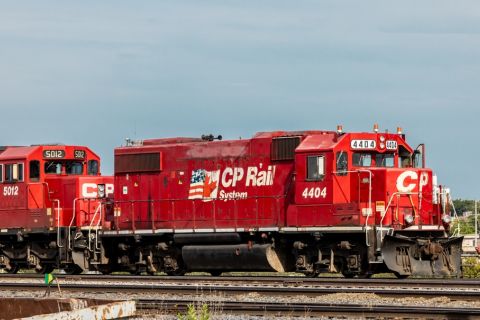The decision to use completely disintegrating frack plugs and frack balls across three wells in the Woodford Shale in Oklahoma enabled an operator to successfully install an interventionless plug-and-perf (PNP) completion and save nine days—and about $200,000—in rig costs. All plugs and balls performed flawlessly and showed positive indication of diverting the fracture treatments as planned. When brought online, IP from the wells was 20% greater than planned.
The three wells were completed with 5.5-in. 20-lb/ft casing. Each completion was cemented in a single long string ideal for PNP operations. Two of the wells were drilled with a true vertical depth (TVD) near 2,743 m (9,000 ft) and laterals roughly 1,524 m (5,000 ft) long. Well design called for using disintegrating plugs to isolate all stages in these two wells. The third well had a similar TVD but included a 3,200-m (10,500-ft) extended-reach lateral. In this multistage well only the 15 deepest stages would use disintegrating plugs, while the shallower stages would be perforated using standard composite plugs.

Composite plug limitations
PNP completions with composite plugs account for an estimated 80% of new well completions in North America. The plugs enable flexible stage placement, provide fullbore access after plug drillout and allow treatment of stages as far as wireline and coiled tubing (CT) can reach while offering a long track record of field success.
Historically, however, when using traditional composite plugs in a standard PNP completion, the plugs must be milled out before hydrocarbons can flow through the wellbore. Mills are typically run in using CT, and the debris is circulated out of hole. This process takes time, both in terms of preparation and execution. Production startup might be delayed for three or more days while the plugs and drop balls are drilled out using CT-conveyed milling tools and debris is circulated to surface.
Drilling extended laterals in excess of 3,050 m (10,000 ft) is a common practice in some basins. For most PNP completions, however, wellbores are generally confined to lengths that match the reach of CT units in the region. Applying sufficient weight on a milling bottomhole assembly to enable drillouts becomes unreliable in wells with extended horizontal wellbores. Composite plugs left in the well create a production barrier for the stages below, preventing recovery of hydrocarbons from that area.
Interventionless alternatives
Several new interventionless completion technologies have improved PNP completion efficiency by eliminating time, cost and risks associated with post-frack drillouts. While these solutions might save some time upfront by eliminating post-frack intervention, they can complicate operations, both initially and later in the life of the well. Disappearing frack plugs that do not fully disintegrate leave behind partial or whole components that can damage equipment both downhole and at surface and cause problems during intervention. For example, standard frack plugs use cast iron slips and rings or ceramic buttons coupled with a packer to create a tight seal and hold plugs firmly in place. These high-strength materials do not degrade.
Complete disintegration solution
After reviewing available technologies, the operator chose to run completely disintegrating SPECTRE frack plugs and IN-Tallic balls. The balls and plugs are made of materials based on the application of a high-strength nanocomposite technology known as controlled electrolytic metallic (CEM) material. Developed and patented by Baker Hughes, CEM material exhibits substantially continuous cellular metallic grains dispersed in a nanomatrix. The nanomatrix reinforces high strength but also exhibits a unique chemical disintegration property that conventional materials do not provide.
In the processed state, these nanostructures act as intermetallic adhesion promoters, which yield metal composites that can withstand 10,000 psi differential pressure—sufficient for reliable diversion of stimulation treatments into the formation. By comparison, typical flow rates in hydraulic fracturing are below 15 bbl/min. At the same time, devices made from the CEM material can completely degrade in situ within a predetermined period of time when exposed to wellbore fluids. The designer material, which has been used in the fracturing of more than 100,000 stages, disintegrates fully at predictable rates based on temperature and salinity.
During run-in the risk of obstruction-related presets is significantly reduced by the plug’s impact-resistant design, which distributes forces up through the tool string instead of the slip system. At the desired depth, the packing element expands and seals against the casing, and the slip system secures the plug firmly in place. Because the plug’s components are constructed of material that only reacts with produced fluids, there is no risk of premature degradation.
Disintegrating frack balls are seated on top of the completely disintegrating plugs to divert fracture treatments. After fracturing, the plug and frack ball disintegrate completely, leaving behind a debris-free fullbore inner diameter (ID) that enables future wellbore access without concerns around ID restrictions or debris-related tool complications.

Success in the Woodford Shale
The operator in the Woodford Shale deployed 47 completely disintegrating frack plugs to complete the wells—15 near the toe of the extended-reach well, with the deepest being set at 4,270 m (14,012 ft)—and 16 in each of the other two wells. Each frack plug was run in hole on wireline and set. Then a disintegrating frack ball was dropped and seated on the plug, enabling treatment of each stage. All plugs and balls were deployed flawlessly and showed positive indication of diverting the fracture treatments as planned. After the fracturing job on each well was completed, the well was shut in briefly while production equipment could be installed. When brought online, uplift was recorded to be 20% greater than planned, indicating that all plugs disintegrated as expected, leaving a clear wellbore and delivering greater-than-expected production.
Using the CEM material-based disintegrating frack plugs and frack balls across all three wells saved the operator an estimated nine days of rig time. It also enabled the operator to successfully install an interventionless PNP completion.
Recommended Reading
CorEnergy Infrastructure to Reorganize in Pre-packaged Bankruptcy
2024-02-26 - CorEnergy, coming off a January sale of its MoGas and Omega pipeline and gathering systems, filed for bankruptcy protect after reaching an agreement with most of its debtors.
NGL Growth Leads Enterprise Product Partners to Strong Fourth Quarter
2024-02-02 - Enterprise Product Partners executives are still waiting to receive final federal approval to go ahead with the company’s Sea Port Terminal Project.
After Megamerger, Canadian Pacific Kansas City Rail Ends 2023 on High
2024-02-02 - After the historic merger of two railways in April, revenues reached CA$3.8B for fourth-quarter 2023.
Enbridge Advances Expansion of Permian’s Gray Oak Pipeline
2024-02-13 - In its fourth-quarter earnings call, Enbridge also said the Mainline pipeline system tolling agreement is awaiting regulatory approval from a Canadian regulatory agency.
Canadian Natural Resources Boosting Production in Oil Sands
2024-03-04 - Canadian Natural Resources will increase its quarterly dividend following record production volumes in the quarter.





